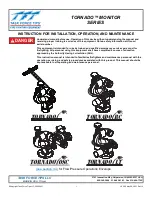
Arrow Manual
Glossary
244
D/A Acronym for “Digital to Analog,” which refers to the conversion of a digital data to an
analog signal.
DAW Acronym for “Digital Audio Workstation” – that is, any device or software that can
record, play back, edit, and process digital audio.
dB Abbreviation for “decibel,” a logarithmic unit of measure used to determine, among
other things, power ratios, voltage gain, and sound pressure levels.
dBm Abbreviation for “decibels as referenced to milliwatt,” dissipated in a standard load
of 600 ohms. 1 dBm into 600 ohms results in 0.775 volts RMS.
dBV Abbreviation for “decibels as referenced to voltage,” without regard for impedance;
thus, one volt equals one dBV.
DI Acronym for “Direct Inject” or “Direct Input,” a recording technique whereby the
signal from a high-impedance instrument such as electric guitar or bass is routed to an
input. DI into mixer or tape recorder inputs often employ use of a “DI box,” which raises
the signal to the correct voltage level at the right impedance.
Digital Information or data that is stored or communicated as a series of bits (binary
digits, with values of 0 or 1). Digital audio refers to the representation of varying sound
pressure levels by means of a series of numbers. (See “Analog” and “Bit”)
Dither Minute amounts of shaped noise added intentionally to a digital recording in order
to reduce a form of distortion known as “quantization noise” and aid in low level sound
resolution.
Dry Refers to a signal that is unprocessed, e.g., recording a dry signal. The antonym of a
“wet” signal.
DSP Acronym for “Digital Signal Processing” (or “Digital Signal Processor.”)
DSP Accelerator A device dedicated to digital signal processing. UAD-2 devices are DSP
accelerators.
Dynamic Microphone A type of microphone that generates signal with the use of a very
thin, light diaphragm which moves in response to sound pressure. That motion in turn
causes a voice coil which is suspended in a magnetic field to move, generating a small
electric current. Dynamic mics are generally less expensive than condenser or ribbon
mics and do not require external power to operate.
Dynamic Range The difference between the loudest sections of a piece of music and
the softest ones. The dynamic range of human hearing (that is, the difference between
the very softest passages we can discern and the very loudest ones we can tolerate) is
considered to be approximately 120 dB. (See “Bit resolution”)
EQ Abbreviation for “Equalization,” a circuit that allows selected frequency areas in an
audio signal to be attenuated or boosted.
External Clock A clock signal derived from an external source. (See “Clock”)
FET Acronym for “Field Effect Transistor.” A type of transistor that relies on an electric
field to control the shape, and hence the conductivity, of a “channel” in a semiconductor
material.
Summary of Contents for Arrow
Page 272: ...www uaudio com ...
















































